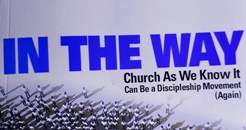 Contrasting 'Church as we know it' and 'Disciple-multiplying movements' - 2
Contrasting 'Church as we know it' and 'Disciple-multiplying movements' - 2
From a talk by Simon Holley and a book In the Way by Damian Gerke
The previous article in this series is here.
Following on from interest in the articles, Repositioning church as a mission agency and The Underground, I listened to a talk by Simon Holley, who leads the eldership and strategic leadership teams at King’s Arms Church in Bedford. He also leads the team that serves the Catalyst family of churches. He recently gave a brief talk on some of the principles and practices of Disciple Making Movements to start the conversation.
The premise of the book 'In the Way' is that church as it is currently practiced in the West is not the only model of church and, if multiplication is the desired outcome, it is in fact an inferior model.
The book contrasts 25 aspects of ministry which highlight the differences between a 'Disciple-multiplying movement' and 'Church as we know it'. Leaving out some for brevity, let's look at some more contrasts between 'Church as we know it' and a 'Disciple-multiplying movement':
2. What the Church does - Activities
Church as we know it
|
Disciple-multiplying movement
|
Its Ministry Goal is Salvations. Emphases (and metrics) concern conversion and individual salvation in Christ, leading to baptism. There could be an assumption that being saved means you are a disciple. Helping people get saved is different from 'go and make disciples'.
|
Its Ministry Goal is Disciple-Makers. Emphasis is on discipleship as a process of following Jesus and living as he lived, which includes personal salvation. Activities are equipping people to be disciple-makers.
|
The primary Method is Teaching. Prominence of sermon, Sunday school, small group Bible study.
|
The primary Method is Training. This involves teaching but also many other elements. It is developmental - teach, demonstrate, let people try. Think how you would learn to paint, play sport, etc., - this is training.
|
Key Metric is Attendees.
|
Key Metric is Capable Disciple-Makers.
|
Primary Meeting is Congregation. Requires large, equipped space, a programme, significant investment of time and energy. A few-on-many, passive experience.
|
Primary Meeting is Small Group. Highly participative, flexi-location, simple, training, mutual accountability, praying, one-anothering.
|
|
|
|
Simon comments:
Teaching vs. Training
The proportion of time people spend receiving teaching vs training is out of balance to the required outcome. We’ve been quite good at teaching. We’ve spent hours preparing sermons and delivering them. It’s not bad - it’s good. The problem is - it’s not enough because the goal is not just to educate, but to do two things - one is to align their lives to follow Jesus - to be transformed in their character and behaviour and the other is to equip people to be disciple-makers as consistently and quickly as possible.
Jesus’ emphasis was not just on teaching more knowledge but in transforming lives and sending those people out to transform others. So the problem is that teaching is not enough to achieve those goals. Think of the way we learn other things in life that are more than just intellectual knowledge: Football, woodworking, sewing. You would never expect people to learn those activities by listening to a speaker talk about them. Instead, you would teach a concept, then demonstrate, then let them try it. After some correction and focused advice, you let them try it again until they reach a base level of competency. Then you move on to the next concept and repeat the process. The same is true for training someone to disciple others. Teaching is only one aspect of discipleship, and as surprising as this may sound it’s not the most important.
Attendees vs. Capable Disciple-Makers
If people see themselves as going to church then typically they see themselves as belonging to an organisation rather than as a disciple maker. We can moan about this but actually the problem starts with us because we track salvations. We’ve never tracked how many of those became disciple makers! We’ve diligently tracked how many come on a Sunday and how many are in groups but what we should have been tracking is how many capable Disciple-Makers have we made this last year. We complain about consumerism but we can inadvertently perpetuate the very consumers we complain about.
3. How the Church is led and developed
Church as we know it
|
Disciple-multiplying movement
|
Its Leadership is Professional. Its hierarchical structure and clergy-laity divide places leaders above others and bestows positional authority. Leadership is narrowly distributed in narrow roles and they are often overwhelmed. Lack of opportunities. Hard to develop leaders. Education process in Bible Colleges, etc., is expensive and long.
|
Its Leadership is generally Bivocational. Working in the marketplace - practical skills, in the harvest, financially freeing. Leadership is developed organically and confirmed as they disciple others. It's an apprenticeship process where authority and responsibility is given away early and often. Servant leadership.
|
Maturity is Knowledge.
|
Maturity is Christlikeness.
|
Equipping Gifts are mainly Shepherds and Teachers. If strong it leads to para-church ministries effectively outsourcing missional opportunities.
|
Equipping Gifts are Apostles, Prophets, Evangelists, Shepherds and Teachers (APEST) - Ephesians 4.
|
Management Approach is Control. Hierarchy, strengths of Shepherds and Teachers, narrow leadership leads to order, consistency and structured approaches and control to maintain this.
|
Management Approach is Release. Preparing people to follow the direction of the Holy Spirit, expect answers to prayers, obey God's voice from pages of the Bible.
|
|
|
|
The next part of this review is here.
Retweet about this article:
From a talk by Simon Holley and a book In the Way , 08/03/2022